Is Lyme Disease a Big Problem Where You Live? Maybe Not.
I was just reading a really neat article by @mountainjewel on a seed bank found here in the Ozarks. In the intro of her article, she mentioned how she was concerned about Lyme disease and so was doing research on it. That got me thinking that maybe other people might be interested in the research that I have done into Lyme disease.
When I first moved here to the Ozarks from the city, I was shocked by the number of ticks here. In Ohio, I had never gotten a single tick on me even though I was an avid hiker. However, after the first couple of days here on our Ozark homestead, we realized that tick checks would be a normal part of life (as would putting our clothes in the dryer to kill the ticks when we came in from outside). We were a bit concerned as we had heard about Lyme disease and how ticks spread this horrible disease. That is when I began to research.
The first part of my research lead me into finding out that not all ticks can carry the bacteria (which is called Borrelia burgdorferi). The deer tick is the carrier on the east coast of the US, and the black-legged tick is the carrier on the west coast. Somewhat confusingly, the deer tick is also sometimes referred to as the black-legged tick (since it has black legs), while others say the black-legged tick is a different species entirely. In either case, these two are the main culprits. Below, you can see a picture of a deer tick and a black-legged tick.
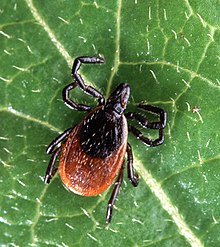
Adult Deer Tick
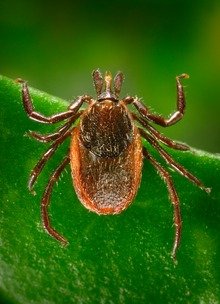
Adult Black-Legged Tick
Both images are taken from Wikipedia
There are other common ticks that are not spreaders of Lyme disease. The most common in our area is the Lone Star tick (picture shown below). The white dot on its back is very conspicuous and makes it easy to distinguish. We actually found that on our land, the Lone Star tick was more common than the deer tick.
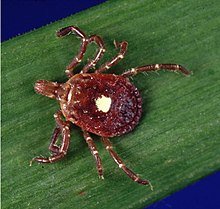
Image from Wikipedia
For some of you, the dog tick might be common (picture below). It is also NOT a transmitter of Lyme disease.
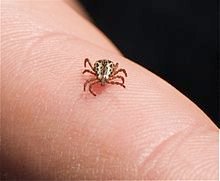
Image from Wikipedia
So, I guess the first lesson is to KNOW YOUR ENEMY. Is the tick that is crawling on you really a possible carrier of this disease? There is a chance that it can't even carry the Lyme disease causing bacteria.
Okay, so after finding this out, I actually felt a little better, but still not completely at ease. I mean, we had deer ticks on our land for sure. So does that mean our land is crawling with Lyme disease? Well, not really. A bit more research shows that even though deer ticks CAN carry the disease and transmit it to humans, NOT ALL deer ticks actually carry the bacteria.
Each year, researchers across the US perform a simple test for Lyme disease and determine the risk of getting Lyme disease from a tick. What is the test? They collect many blood samples from dogs and test their blood for the presence of antibodies to the bacteria causing Lyme disease. You see, when an animals has been infected with a disease, its immune system will form antibodies which help fight the disease. At the same time, the animal's body will save some of these antibodies to help quicken an immune response if ever infected a second time. Because of this, we can test for these antibodies and see if the animal had ever been exposed to the bacteria. No antibodies, no bacteria.
So once they get this information, they compile this information into a risk map. They show, county by county, the percentage of dogs that contained the antibodies for Lyme disease bacteria. And this will then be a good indicator of where in the US you have a good (or bad) chance of getting Lyme disease from a tick.
Here is the map for 2017.
Image from www.goodhousekeeping.com (but they probably got it from some other source)
And it was this image that really made us more at ease. From this image, we saw that our county had virtually no risk of Lyme disease.
So, how about you? How does all this make you feel? More at ease? More concerned? Either way, knowledge is power. And if you are still concerned about it, get a few guinea fowl - one of the most potent tick destroyers of them all.
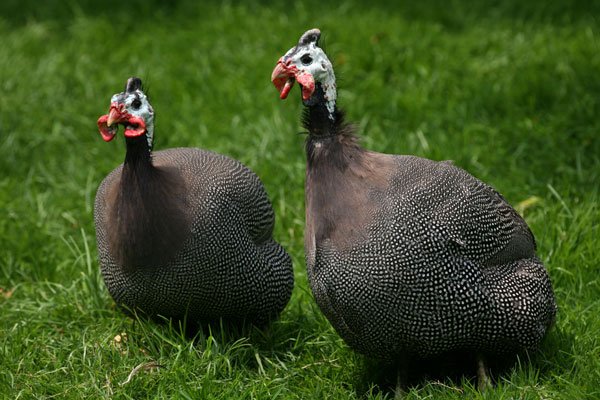
Image from www.motherearthnews.com.
Great post!
Like most risks, putting them into a proper perspective is helpful.
I find that many times, the unknown is scarier than the known. Knowledge brings things to light and makes them less of a monster.
Definately!
My anecdotal personal experience tells me not to be so confident in these maps. It’s a dark blue in my area, yet my wife, and so many friends, have gotten Lyme within the past few years. I would talk to doctors and friends in your general area to see if how prevalent it is. It took us a year to diagnose my wife because we thought it was rare in are area. Turns out it wasn’t.
There is a good chance lyme disease is under-diagnosed.
It is quite possible that infected individuals will show no or minimal symptoms of bacterial infection.
Lyme is tricky at best and has a VERY strange and quite disturbing history.
Yup, a map is what it is. Statistics are one thing, but if your loved one is the one in a million that gets something, it doesn't really matter that it is a one in a million chance. Because really, that one was the one you really cared about. I am just glad she has a supportive husband to walk with her on this difficult path.
If it was just my wife it would be one thing, the doctors themselves have said they are seeing the cases rise, and it's very under diagnosed. We've also had multiple friends in our area contract it within the past few years.
This past season we had horrible ticks here. Found out from the local vet that we live in the hot spot of ticks in this state.
Found one on the dog and husband earlier in the summer- but luckily we got them before they got under the skin.
Could you tell what type they were? As I mentioned, we found that Lone Star ticks were more common on our land. What about yours?
Where we grew up lymes disease was a HUGE deal. When we rescued our second dog here that was covered in ticks we asked if we could get him tested for lymes disease and the vet looked at us like we were nuts. We didn't know it wasn't really a thing around here
Yeah, some areas seem to be real hot spots for it, while others... not so much. But, some places also just don't seem to have the data to know that they have it.
It's interesting to track the results of the University of Arkansas Tick Study. They are trying to answer the questions of what kinds of ticks are in the state, and what kinds of diseases they are carrying.
The tick study has tried to get a lot of samples from the Ozarks area, as well as other parts of the state. They have found at least 5 different species. And each kind carries different diseases, like you say. Collectively, there are a lot of tick-borne diseases, like this Extension pamphlet points out. According to them, Arkansas ranks high for cases of Rocky Mountain spotted fever, ehrlichiosis, tularemia and anaplasmosis. So Lyme disease isn't the only risk.
All I know is that when I visit my parents, who live in Arkansas, it gets real old dealing with hundreds of deer tick nymphs in the spring! I'd rather prevent them being on me, rather than try to find them every day!
For sure! We are the same way. Having chickens free-ranging on our homestead has really decimated the tick numbers, but we heard that guinea fowl are even better, so we will be getting those in the not-too-distant future. Periodic burning is also supposed to help control numbers - something that people probably don't do as often as naturally occurs.
And if we knew every possible disease out there carried by every possible critter, no one would go outside for fear. It gets to the point where you just have to trust that the design of our bodies is good, and the fact that a healthy adult's body can usually fight off these things. Most people have probably gotten many more diseases than they know but just never had any symptoms.
Guinea fowl do work well for keeping the ticks at bay, in the areas they roam. In the woodlands, it's good that the opossums eat a lot of ticks! My parents enjoy having plenty of possums around. That's a great point about burning. With more lands being managed that way, it should be pretty clear before too long, how effective that is at reducing tick numbers. Having cover that keeps local humidity high really does seem to foster more ticks.
For your last point, I agree for many risks. I've generally been happy to be an asymptomatic carrier, lol. The changes in blood borne diseases over the last few decades are real and are having real impact. I've stepped up my tick-avoidance in areas where they are common, beyond the old sulfur-in-a-sock that I grew up with, lol.
What is the ""sulfur-in-a-sock"? Is that an effective way of keeping ticks off you? Where did you get the sulfur from as a kid?
That's what I grew up using. It's just an old sock (with no holes) and 1/2 to 1 cup of powdered elemental sulfur in it, down in the toe of the sock. Then the top of the sock is tied in a knot. And it's hung up by the door, ready to use.
When we'd go outside to pick blackberries or go in the tall grass, we'd pull our own socks up over the bottom of our pantlegs. Then we would 'whack, whack, whack' that sock all around our shoes and lower legs, and up around our belt. Some sulfur would come out of the sock onto our clothes.
It really did seem to work to keep off both ticks and chiggers. But tick diseases were not so much an issue back then. It was easy to get the powdered elemental sulfur at any hardware store. And at a pharmacy counter, too.
Hmm...I wonder where we can get that stuff now. I will have to check the local store to see if they have it. Does it smell like you would expect sulfur to smell (like rotten eggs)?
I don't think it smells so bad. It's not noticeable on your clothes. There was a time, a few years ago, when it didn't seems to be so available. But it looks like you can get it online now.